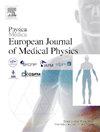Direct comparison of PMT and SiPM PET systems using modified NEMA IEC Body phantom
IF 3.3
3区 医学
Q1 RADIOLOGY, NUCLEAR MEDICINE & MEDICAL IMAGING
Physica Medica-European Journal of Medical Physics
Pub Date : 2025-02-09
DOI:10.1016/j.ejmp.2025.104919
引用次数: 0
Abstract
Purpose
This study aimed to compare the image quality of the Siemens Biograph mCT40 (photomultiplier-based system – PMT) and the Siemens Vision600 (silicon photomultiplier-based system – SiPM) using a modified NEMA IEC Body phantom (Data Spectrum).
Methods
SiPM-based Vision600 has a smaller crystal size (3.2 × 3.2 mm vs. 4.0 × 4.0 mm in the PMT-based mCT40), resulting in better spatial resolution. Enhanced time-of-flight (TOF) timing and higher sensitivity leads to nearly four times higher effective sensitivity. The standard NEMA IEC Body phantom was modified with a 3D-printed holder to accommodate also Hollow and Micro Hollow Spheres of 15.4 mm, 12.4 mm, 7.9 mm, 6.2 mm, 5.0 mm, and 4.0 mm. Each of the three acquisition sessions per scanner included 18 time points and spanned 5.6 half-lives to assess system performance at varying activity concentrations in the field of view.
Results
Recovery curves for both systems were similar when identical post-reconstruction filters were applied. The SiPM-based Vision600 system detected smaller sources at significantly lower activity concentrations, and the variations in standardized uptake value (SUVmax, SUVA50) measurements were generally smaller compared to those of the PMT-based system. The two smallest sources became undetectable below 63 MBq and 16 MBq on the PMT system, versus 20 MBq and 6.5 MBq on the SiPM system.
Conclusions
SiPM technology demonstrated superior performance compared to PMT in detecting small sources in low-activity scenarios and provided more robust quantification results. It is recommended to use averaged SUV metrics, such as SUVA50 or SUVpeak.
求助全文
约1分钟内获得全文
求助全文
来源期刊
CiteScore
6.80
自引率
14.70%
发文量
493
审稿时长
78 days
期刊介绍:
Physica Medica, European Journal of Medical Physics, publishing with Elsevier from 2007, provides an international forum for research and reviews on the following main topics:
Medical Imaging
Radiation Therapy
Radiation Protection
Measuring Systems and Signal Processing
Education and training in Medical Physics
Professional issues in Medical Physics.

 求助内容:
求助内容: 应助结果提醒方式:
应助结果提醒方式:


